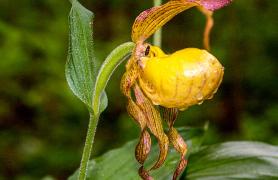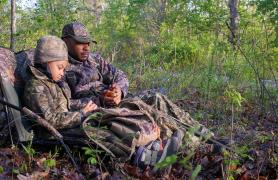The recipe is simple: provide the proper food, water, and shelter, and in no time, you’ll have a yard full of fluttery, flighty, little friends. Another primer on attracting monarchs? Not this time. Maybe now it’s time to reach out to that backyard visitor who doesn’t make friends as easily as the poster child for pollinators. Maybe now it’s time to make room for batty.
Unlike monarchs — and butterflies and birds in general — bats are burdened with centuries of prejudice, spawned by literature and myths stemming from their nocturnal nature. Like their more generally accepted flying counterparts, bats play an important role in the backyard ecosystem and benefit from many of the same landscaping steps we take to make our backyards more hospitable to other species we enjoy.
Bats in Your Backyard
After accounting for species that haven’t been seen in decades or only visit the state on accident, Missouri is home to 16 species of resident bats (See Bats of Missouri), but most city-dwelling Missourians are likely to encounter only two of these, said MDC Naturalist Shelly Colatskie, a bat biologist.
“In urban areas, you’re going to likely see the big brown bat and the eastern red bat,” Colatskie said. “Big brown bats are often associated with houses, barns, manmade structures, and hollow trees, but red bats are associated with leaf litter, so they’re actually in the leaves of the trees or underneath the leaves on the ground. You can see both of those in urban areas, but one’s going to be on your house, versus one is going to be in your trees.”
Nature’s Insect Control
Given their nocturnal nature, most will only see bats right after dusk and right before dawn, and then only in silhouette, so bat viewing in your backyard is limited. What, then, would be the incentive to lure them to set up house on your property? In two words, insect control.
“All of the bats in Missouri and most of the bats in the United States eat insects,” Colatskie said. “They really do eat mosquitoes, maybe not as many as we hoped, but they do eat mosquitoes — and a lot of other crop pests.”
According to Bat Conservation International (BCI), an organization dedicated to protecting bats and educating the public about issues bats face, scientists estimate that bats in the United States are worth more than $3.7 billion a year in reduced crop damage and pesticide use.
Blooms for Bats
When building a hospitable backyard habitat for bats, the first step includes adding native plants to your landscape, Colatskie said.
“A lot of people have been planting more native plants to attract more insects for the bats to eat,” she said. “Any kind of native plants that attract pollinators — as well as other insect life — is going to help feed the bats.”
When adding natives to your yard, make sure to choose plants appropriate for the available sunlight and soil type. Choosing a variety of plants that bloom at different times of the year will ensure that there’s always a selection of insects for the bats. The Missouri Prairie Foundation’s Grow Native! website (moprairie.org/GrowNative) can help with plant selection.
Trees — Dead or Alive
While flowering native plants draw the insects on which bats feed, trees — both dead and alive — provide shelter for many bat species, Colatskie said.
“If you have acreage, leaving some dead trees in areas is perfect, not only for other wildlife, but for bats as well,” she said. “They love the hollow trees as well as underneath the bark, so leaving dead trees is definitely going to help a wide variety of bat species.”
If leaving dead trees, commonly referred to as snags, isn’t possible, many species of bats, including the eastern red bat, also roost in live trees.
“A lot of them roost in oak trees because they hold their leaves longer in the winter,” she said. “If it’s above freezing, they’re going to be in the clumps of the leaves in the tree. If it’s below freezing, or even if it’s below 40 degrees or so, they’re going to be under the leaf litter. It’s kind of warmer under the leaf litter.”
Even after the trees drop their leaves, they still provide shelter for the eastern red bat. “You don’t necessarily have to rake leaf litter all the time, especially if you have an area with a lot of leaves, and that’s going to help other animals, too,” she said. “The eastern red bat will be under the leaf litter, especially oak leaves.”
Bat House
Unlike the eastern red bat, the big brown bat is more likely to take advantage of a manmade structure, whether it’s a home you’ve built for yourself or one you’ve built for them.
“The big brown bats really benefit from bat houses in areas that have a high bat population, especially urban areas, like downtown areas,” Colatskie said.
The big brown bat can frequently be found in the small gaps of shutters, siding, fascia board, and eaves, and, if given the opportunity, your attic. Providing alternative roosting options is vital if you’re evicting bats from your home.
“If you have a really big population of bats in your attic and are removing them, having bat houses on your property is going to be tremendously helpful,” she said.
For those without an established population in need of relocation, attracting bats to a bat house is not guaranteed.
“The average person putting up a bat house just to attract them, that’s really hit or miss,” she said. “You may get one, you may not. It might take several years for them to find it.”
There are steps you can take to increase your odds of having bats occupy your houses, including choosing the right type of house, placing it in the right place, and maintaining it.
Chambers and Rockets
BCI recommends two different types of bat house: multi-chamber houses and rocket boxes.
Multi-chamber bat houses are the most readily recognized design, typically at least 14 inches wide and 20 inches high, but only 2–3 inches deep. The chambers within this roost are ¾-inch deep, making for the tight squeeze bats seek. They can be mounted on the sides of buildings or back-to-back on poles. BCI recommends against using the similar-looking single-chamber houses or houses smaller than 14 by 20.
The rocket box bat house is exclusively a pole-mounted design with four equal sides of approximately 10 inches and a length of approximately 3 feet. These houses have ¾-inch inner and outer chambers, which allow the bats to control the temperature inside by huddling together in the inner chamber for warmth or spreading apart in the outer chamber to cool off.
Perhaps more important than the style of the house is the location of the house. Regardless of whether a house is building or pole mounted, BCI recommends that it be placed in an area that gets at least 6–8 hours of direct sunlight daily, 20–30 feet from tree branches or other obstacles, and 12–20 feet above ground.
“It mimics the height and conditions of where they would naturally roost,” Colatskie said.
Although bats naturally roost in trees, BCI discourages placing houses in trees. Houses in trees leave bats exposed to predators, including owls and hawks, who perch nearby to snag bats as they leave the house, and snakes and raccoons, who can climb the tree to reach those bats still in the house.
Tree foliage also shades houses, blocking the needed sunlight that keeps the houses warm, and frequently obscures the clear approach needed for take-offs and returns.
Once chosen and installed, bat houses require annual maintenance to make sure the only occupants are the ones you’re wanting to attract, Colatskie said.
“During the winter time when bats aren’t there, get up there and clean them out,” she said. “Clean out the wasp nests; that will really help because they don’t like to roost with the wasps.”
Wide Open Spaces
Planting natives and providing shelter are steps that can be taken almost anywhere, but those working with larger parcels of land have an additional opportunity to attract bats if they have access to the third essential element — water.
Bats don’t perch like birds, so they require water sources larger than the traditional birdbath, Colatskie said.
“Ponds are excellent for bats,” she said. “They actually drink as they’re flying.”
BCI research suggests that the most successful bat houses are those located within ¼ mile of a pond, lake, stream, or river.
Patience Pays Off
There are no shortcuts in getting bats to take up residence in your bat houses, Colatskie said.
“People say bring guano to the bat house; that’s just a myth,” she said. “It’s going to be completely hit or miss.”
Similarly, attempting to catch bats (which is illegal without proper permits generally reserved for conservation and academic research) and introduce them to a bat house is unlikely to be successful, according to the BCI website:
“Catching and relocating bats to new areas is, in any case, highly unlikely to succeed. Bats have strong homing instincts, and once released into a bat house, will attempt to return to their former home area. Consequently, placing bats in a bat house is usually futile and is not recommended. If a bat house remains unoccupied after two full years, consider repositioning or modifying the house.”
Nothing in nature is guaranteed. But with proper placement and plenty of patience, planting natives, and installing bat houses can result in some long-term satisfaction if one’s goal is enjoying the dusk and dawn flights of Missouri’s native bats, Colatskie said.
“Usually these guys are pretty loyal to their spots, so they’ll come back from year to year to year if they find the right spot.”
Bat Facts and Myths
- Despite their somewhat mousy appearance, bats are not members of the rodent family.
- Missouri’s largest native bat is the Hoary Bat, which weighs up to 30 grams.
- Bats are less likely than most wild mammals to contract rabies. Less than half of one percent of bats have the disease. Experts warn that any bat that is easily approachable is likely sick and should not be approached or handled.
- Missouri’s smallest native bat, the Eastern Smallfooted Myotis, weighs only 3–4 grams.
- Gray Myotis can have hibernation colonies of 500,000 and maternity colonies of 200,000.
For more information on bats in Missouri, visit short.mdc.mo.gov/ZQR. Information from and about Bat Conservation International (BCI) is available at batcon.org.
Bats of Missouri
The eastern red bat (Lasiurus borealis) and big brown bat (Eptesicus fuscus) are the two most common of Missouri’s 16 species of bats.
Of the remaining species, many are threatened or endangered:
- Little brown myotis (Myotis lucifugus)
- Gray myotis (Myotis grisescens)
- Southeastern myotis (Myotis austroriparius)
- Northern long-eared myotis (Myotis septentrionalis)
- Indiana myotis (Myotis odalist)
- Eastern small-footed myotis (Myotis leibii)
- Silver-haired bat (Lasionycteris noctivagans)
- Tri-colored bat or eastern pipistrelle (Perimyotis subflavus)
- Hoary bat (Lasiurus cinereus)
- Seminole bat (Lasiurus seminolus)
- Brazilian free-tailed bat (Tadarida braisiliensis)
- Evening bat (Nycticeius humeralis)
- Ozark big-eared bat (Corynorhinus townsendii ingens)
- Rafinesque’s big-eared bat (Corynorhinus rafinesquii)












Also In This Issue


And More...
This Issue's Staff
Editor - Angie Daly Morfeld
Associate Editor - Larry Archer
Staff Writer - Bonnie Chasteen
Staff Writer - Heather Feeler
Staff Writer - Kristie Hilgedick
Staff Writer - Joe Jerek
Art Director - Cliff White
Designer - Shawn Carey
Designer - Les Fortenberry
Designer - Marci Porter
Photographer - Noppadol Paothong
Photographer - David Stonner
Circulation - Laura Scheuler






















